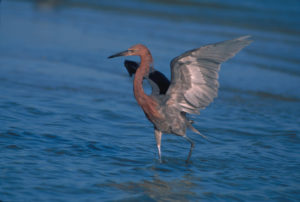
A recent study of wading birds in Bahía Kino in Western Sonora, Mexico, may prove critical to future efforts to conserve birds and their habitats in this unique and vital area. Located on the east coast of the Gulf of California, Bahía Kino is notable for its high diversity of bird species due to its close proximity to marine, desert, mangrove and island ecosystems. The area is home to large colonies of seabirds such as Double-crested Cormorants and Brown Pelicans, as well as relatively less common seabirds, including Craveri’s Murrelet.
The rapid development of the region, and especially the establishment of large scale mariculture operations along Estero Santa Cruz, has the potential to impact local wading bird populations. Thus, an understanding of wading bird diversity, abundance and habitat is essential to inform future management and conservation initiatives.
The study, published in the May 2015 issue of Waterbirds, examines the occurrence and nesting phenology of wading bird species from 2009-2013. Researchers surveyed two active colonies, one in a mangrove estuary and another on a nearshore desert island. Researchers also sampled potential prey of wading birds in the estuary, with special focus on brachyuran crabs, which constitute the main prey items of the Yellow-crowned Night-Heron.
Key Findings:
• Researchers recorded 13 species of nesting wading birds, 11 of which are year-round residents. The most abundant species was Snowy Egret, which had a peak of 234 nests in 2012. Of particular conservation interest is the Reddish Egret, which had a peak of 149 nests in 2012.
• The most species-rich habitat is the mangrove zone. Researchers found that 100% of the wading bird species studied used Estero Santa Cruz, which is dominated by mangroves. The presence of mangrove habitat may be a key factor in supporting wading bird species richness in the Gulf of California.
• Isla Alcatraz supports the largest breeding population of Reddish Egrets – federally designated as a “species of special concern” in Mexico – in Sonora and the second largest colony in northwest Mexico. This important breeding population deserves special conservation attention.
Access the full report here.


 English
English  Español
Español 